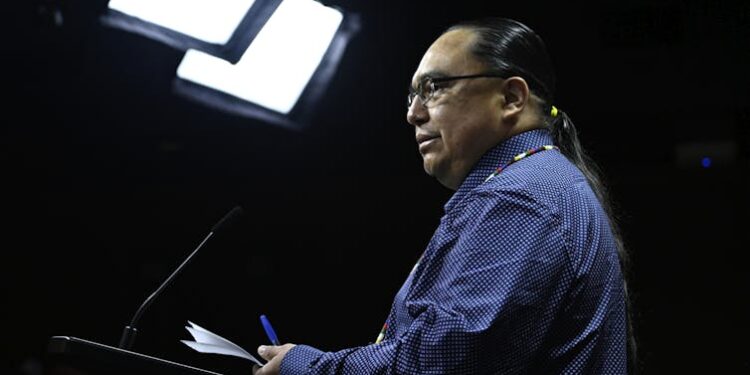If Canada is serious about reconciliation, it must change how it trains health professionals. Right now, too few Indigenous doctors, nurses and other providers are working in communities that need them most. And too often, students learn about Indigenous health in ways that are optional, inconsistent or not led by Indigenous educators.
That’s where Indigenous-led health education comes in. When Indigenous communities shape how health professionals are trained, it supports a path toward trust, equity and a health system that finally reflects the people it serves.
Read more:
Indigenous community research partnerships can help address health inequities
As an Indigenous physician and medical educator practising in Tyendinaga Mohawk Territory, I know firsthand the challenges and the possibilities of this work. I am the first Indigenous woman in Canada to pursue both medicine and a PhD, a journey shaped as much by systemic barriers as by the support of my family and community.
Today, I practise primary care in my home community while helping to shape health education nationally, including via a new Queen’s University partnership program in Western James Bay, Ontario — the Queen’s–Weeneebayko Health Education Program on the traditional territory of the Moose Cree First Nation (Treaty 9).
Seeing the gaps in care in my own clinic, and working with students eager to change the system, informs my commitment to Indigenous-led education as the most direct path to reconciliation in health.
Table of Contents
10 years after the TRC: promises vs. reality
It has been a decade since the Truth and Reconciliation Commission (TRC) released its Final Report. The Assembly of First Nations reports that of the 94 Calls to Action, only 14 have been fully implemented.
Two of them, No. 23 and No. 24, speak directly to health care: train and retain more Indigenous health professionals, and make sure all students learn about Indigenous health and the legacy of residential schools.
THE CANADIAN PRESS/Justin Tang
These aren’t symbolic. They are practical steps that would improve care and save lives. But progress has been slow. Indigenous professionals remain underrepresented, and cultural safety training is too often patchy or optional.
Indigenous-focused health education
A new national report from the Conference Board of Canada confirms what Indigenous leaders have been saying: reconciliation won’t happen unless Indigenous Peoples lead — in education, governance and workforce planning. Token gestures aren’t enough.
The report, Answering the Call: Strategies to Increase the Number of Indigenous Physicians in Canada, notes that “Indigenous students, especially in rural and remote areas, often lack career guidance and a culturally relevant curriculum, leading to lower graduation rates and fewer pathways to medical education.”
While systemic challenges persist, there are powerful examples across Canada that share the common goal of making sure Indigenous students can succeed in health education, and ensuring communities benefit from culturally safe, long-term providers.
The Queen’s–Weeneebayko program I’m directing is building a new health sciences Campus in Moosonee, Ont. Students from the Hudson and James Bay region — including from Moosonee, Fort Albany, Attawapiskat, Moose Factory, Kashechewan and Peawanuck — will be recruited locally, trained in Moosonee and supported to stay serving their home communities.
This partnership, including the Weeneebayko Area Health Authority(WAHA), Queen’s University and the Mastercard Foundation, integrates local Indigenous knowledge and ways of knowing (for example, through Cree language, land-based learning and cultural safety) alongside biomedical science.
Indigenous leadership is embedded at every level — from community knowledge keepers and local education and health-care champions guiding what is taught and how to WAHA operating governance and mentorship frameworks rooted in local culture. I am the inaugural director.
Fostering culturally safe health care
Other programs across the country share the common goal of making sure Indigenous students can succeed in health education, and ensuring communities benefit from culturally safe, long-term providers.
For example:
-
At the University of British Columbia, the Northern and Rural MD Pathway is a distinct admissions stream designed to attract applicants with rural, remote northern or Indigenous community connections — or those passionate about serving such communities — by incorporating a rural and remote suitability Score (RRSS) and early rural placements to support rural and remote training and practice.
-
The University of Manitoba’s Mahkwa omushki kiim: Pathway to Indigenous Nursing Education (PINE) supports First Nations, Inuit and Métis students from start to finish. By combining academic help with cultural programming and community connection, it has the goal of boosting retention as it prepares more Indigenous nurses for practice.
Programs like these are concerned with helping whole communities gain consistent, trusted health care. And when trust grows, so does the likelihood that people will seek care early — improving outcomes for everyone.
Beyond such programs, system-wide change is needed to ensure Indigenous learners are supported at every stage, and to support viable pathways to medical training in rural and remote areas.
System-wide changes needed
Indigenous students face:
Location also matters. Research shows that students trained in rural or remote areas are far more likely to practise there after graduation.
For Indigenous students, viable pathways to practising medicine are even stronger when training is grounded in community values and led by Indigenous educators.
Read more:
Want to decolonize education? Where classes are held matters
THE CANADIAN PRESS/Darryl DyckCP
Why this is reconciliation in action
Reconciliation is not just about apologies or ceremonies. It’s about real, structural change. In health care, that means:
-
Who delivers the care: building a stronger Indigenous health workforce.
-
Whose knowledge counts: recognizing Indigenous knowledge alongside Western medicine.
-
Who makes decisions: ensuring Indigenous voices lead the design and governance of health programs.
Indigenous-led health education tackles all three. It brings reconciliation down from the level of promises and into the day-to-day realities of patients, providers and communities.
The way forward
Ten years after the TRC, Canadians are right to ask whether reconciliation is real. The answer depends on whether we support Indigenous-led programs — not as small pilots, but as long-term, fully resourced commitments.
The initiatives described here show what’s possible. They are different in scope, but each demonstrates that Indigenous self-determination in health education is not only achievable, it’s already happening.
The next step is clear: supporting Indigenous-led education so that reconciliation moves from promise to practice in communities nationwide.
























